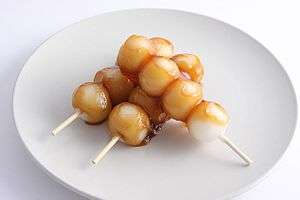Dango
 Mitarashi dango | |
| Type | Dumpling, sweets |
|---|---|
| Place of origin | Japan |
| Main ingredients | Rice flour |
Dango (団子) is a Japanese dumpling and sweet made from mochiko (rice flour),[1] related to mochi. It is often served with green tea. Dango is eaten year-round, but the different varieties are traditionally eaten in given seasons. Three to five dango are often served on a skewer.
Types
The many different varieties of dango are usually named after the various seasonings served on or with it.
- Anko is commonly made with (sweetened) red bean paste; ingredients other than azuki are used on rare occasions.
- Chadango is green-tea flavored dango.[2]
- Botchan dango has three colors. One is colored by red beans, the second by eggs, and the third by green tea.
- Denpun dango from Hokkaido is made from potato flour and baked with sweet boiled beans.
- Kuri dango is coated in chestnut paste.
- Chichi dango is a slightly sweet, light treat usually eaten as a dessert.
- Hanami dango also has three colors, and is traditionally made during Sakura-viewing season, hence the name (Hanami means "flower viewing"; hana meaning "flower", and mi meaning "to see").
- Goma uses sesame seeds. It is both sweet and salty.
- Kibi dango is made with millet flour. This variety is prominently featured in the tale of Momotaro, a folkloric Japanese hero, who offers the rounded ball (not skewered) to three talking animals in exchange for their aid in fighting demons.
- Kinako is made with toasted soy flour.
- Kushi dango' is held by a skewer.
- Mitarashi is covered with a syrup made from shouyu (soy sauce), sugar, and starch.
- Nikudango is a type of meatball.[3]
- Teppanyaki on a skewer has a tangy teppanyaki taste.
- Sasa dango is produced and eaten primarily in Niigata Prefecture. Sasa dango has two varieties: onna dango and otoko dango. Onna dango (literally "female dango") is filled with anko, while the otoko dango (literally "male dango") is filled with kinpira. The dango is wrapped in leaves of sasa for the purpose of preservation.
Derived terms
A common Japanese proverb "hana yori dango" (花より団子, literally, "dango rather than flowers") refers to a preference for practical things rather than aesthetics.
A hairstyle consisting of dango-like buns on either side of the head is sometimes known as odango.
Dorodango is a Japanese art form in which earth and water are molded to create a delicate, shiny sphere, resembling a billiard ball.
Unicode character
The Unicode emoji character 🍡 is used to resemble Hanami dango. The character was introduced in October 2010.[4]
See also
| Wikimedia Commons has media related to Dango. |
References
- ↑ Sasaki, S.; McCabe, S.; Iwasaki, S. (2002). Chado: The Way of Tea. C. E. Tuttle. p. 461. ISBN 978-0-8048-3272-4. Retrieved November 5, 2016.
- ↑ "Wagashi: Chadango and Minazuki". June 29, 2008. Retrieved 2009-03-28.
- ↑ "Niku Dango - Sumo Kitchen". Sumokitchen.com. Retrieved 21 December 2017.
- ↑ "Unicode Character 'DANGO' (U+1F361)". Fileformat.info. Retrieved 2017-03-02.


